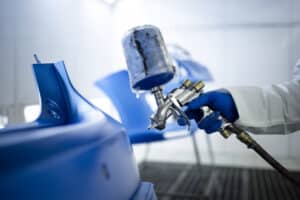Painting Plastic Car Parts: Everything You Need to Know
Painting the plastic fixtures on a car is the perfect way to revitalise the exterior appearance. From plastic wing mirror caps to bumper strips, these can be spray painted to customise the look of your car and make it look new again without needing to work on respraying the entire surface.
So what’s needed, how do you prepare plastic car parts for painting and what methods are required to complete the job itself? Discover all the necessary information on how to apply automotive paint to plastic car parts with the help of this guide.
Which Plastic Cart Parts Can be Painted?
Most plastic trims and parts of a car’s exterior can be painted over. It’s important to note that the plastic trims on vehicles can vary depending on the make and model. This can affect which parts of the vehicle can be painted.
Here are just a few of the plastic car parts that can be painted on most makes and models:
- Trim pieces
- Door handles
- Mirrors
- Bumpers
- Wheel covers
- Spoilers
- Mudguards
Items Needed to Paint Plastic Car Parts
So, what equipment and tools are required to paint the plastic parts? Below is the full list of everything that’s needed:
- Sandpaper: Several different grits of sandpaper might be required to achieve the smoothest possible finish on the plastic.
- Spray paint: Automotive paint that’s suitable for use on plastics is best to go with since it will apply and adhere to the surface better.
- A mask: When working with chemical paints and primers, it’s recommended to wear a mask.
- Primer: An appropriate primer can make a huge difference in whether the paint takes to the plastic surface. Using a suitable primer before painting will ensure that the job is completed to a high standard without the need for reworking.
- Masking tape: We recommend using either our Perforated Trim Masking Tape or Flat Orange Precision Masking Tape to effectively mask around the edge of the plastic trim.
- Lacquer: A clear lacquer will provide a shiny appearance over the new paint job.
- Microfibre cloths: Having a few cloths to hand can be useful for cleaning and polishing.
How to Prepare Plastic Car Parts to be Painted

The best way to prepare plastic car parts to be painted in the initial stages is to remove it from the car’s exterior. This is typically the quickest and most efficient way to prepare the plastic part or trim. Plastic trims can be loosened from the body panel by working a razor or dedicated tool between the two surfaces. Be careful when doing this, since you don’t want to damage the surface underneath or break the plastic moulding.
If removal isn’t possible, you’ll need to mask off the surrounding bodywork to prevent overspray and achieve the best possible finish. For curved parts, we recommend applying our JTAPE Perforated Trim Masking Tape since the perforated edge allows it to mask off bends easily. For plastic parts with straight edges or slight bends, our Lime Precision Masking Tape is perfect for masking off the surrounding areas of the car and preventing overspray. When masking off, the main thing to check is that there are no gaps where paint could seep through, so be sure to apply pressure to your to properly secure it over the panel.
The next thing to do is sand down the surface and ensure it’s as smooth as possible. Work your way up the grit levels and work slowly to achieve the perfect surface ready to paint on. The aim is to remove the shiny surface from the plastic since this will help the primer and paint take hold and provide a lasting paint job.
After the sanding process is complete, clean the plastic part with warm water to remove any dirt or debris left by the sandpaper.
How to Paint Plastic Car Parts
Now that the plastic parts have been correctly prepared, you should be ready to go ahead with painting. Below, we’ll take you through our step-by-step instructions on how to spray paint the plastic trims and achieve an excellent finish.
Step 1 – priming
Apply your high quality primer to the plastic part from around 6-7 inches away. During this stage, you should be wearing a mask to protect from the chemicals in the primer.
For the best application, keep the paint can in an upright position when spraying and apply three or four coats, waiting 15 minutes between each one to allow each layer to dry.
Step 2 – painting

When painting on plastic, more coats of paint might be required for drastic colour changes like covering black parts with white paint. However, the same process can be followed as with the primer regarding how far away the paint can be held.
Step 3 – apply the lacquer
Clear lacquer should then be applied over the paint with four or five coats. Again, leave each layer to dry for around 15 minutes before adding another. Once you’re satisfied with the finish, it’s recommended to leave this to dry for a few hours before removing the masking tape or reattaching the plastic trim.
Step 4 – finish off with polish
The final step is to take a clean microfibre cloth and polish the plastic part. This will bring out the shine and remove any loose debris, leaving you with a perfectly smooth surface.
Can you Powder Coat Plastic Car Parts?
Plastic car parts can be powder coated, although this will usually follow a slightly different process than is used for powder coating alloys. This is because plastic often holds up poorly against the high temperatures that substrates are exposed to during the powder coating process. Instead, a UV-cured powder coating process can be followed to provide your customers with more durable plastic trims.
We hope this guide helps you finesse your approach to painting plastic car parts. For more expert guides and information regarding automotive painting and masking, check out our JTAPE blog.


